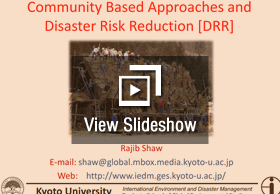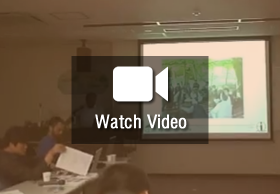

Engaging the community and local stakeholders is an integral aspect of the disaster risk management process. Communities are the core of disaster risk reduction, and community based approaches are increasingly central to national disaster risk reduction plans. Past experience shows that communities are always the first responders in a disaster situation, and take leading roles in post disaster recovery. The roles of communities in pre-disaster preparedness are also very important.
This section may be introduced to participants through lectures comprised of case studies showing different community setups and how they may be integrated as part of a response, recovery and rehabilitation mechanism. Building awareness amongst locals and using them for monitoring their cultural heritage needs to be highlighted.
Community Based Approaches and Disaster Risk Reduction, International Training Course, 2010
Instructor: Rajib Shaw
Read More...


A role play exercise in which the participants engage in various roles as different members of a community and other stakeholders may be carried out to illustrate how it is possible to reconcile different priorities through a prolonged process of community engagement.

Local community set ups vary from place to place. Seen here is a shura system in Afghanistan (Rajib Shaw)
Community Based Approaches and Disaster Risk Reduction, International Training Course, 2010
Instructor: Rajib Shaw | Duration: 60 minutes
Using mapping examples of various cities in India, as well as different initiatives in Japan and elsewhere the community participation approach was clearly illustrated through this lecture.
The session focused on community based approaches of disaster risk reduction. It is essential to understand the nature of every community by analysing its dynamics through identification of the leader, the network and hierarchy and the systems through which the community functions. Only then can sustainable mechanisms be defined and implemented.
The essence of Climate and Disaster Resilience Initiative (CDRI) is the concept of risk versus resilience, which follows a three step process:
The prioritisation of actions for the future becomes possible for a large community of diverse stakeholders.
The five dimensions of resilience were identified as: physical, social economic, institutional and natural environmental policies. Based on these categories, resilience mapping of a city may be undertaken, in a systematic process of planning and implementation. The potential challenges in applying this methodology were also identified, and finally the session concluded with a discussion on town watching as a participatory tool.
References:

